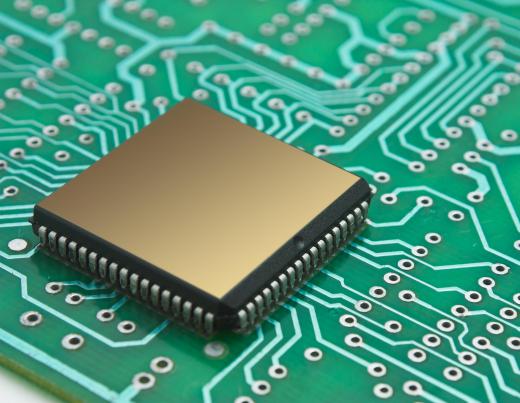What is Plasmonics?
 Michael Anissimov
Michael Anissimov
Plasmons are density waves of electrons, created when light hits the surface of a metal under precise circumstances. These density waves are generated at optical frequencies and are very small and rapid. They can theoretically encode a lot of information, more than what's possible for conventional electronics. Plasmonics is thought to embody the strongest points of both optical and electronic data transfer, allowing the fast transmission of information over very small wires.
Optical data transfer, as in fiber optics, allows high bandwidth but requires bulky "wires" — really tubes with reflective interiors. Electronic data transfer operates at frequencies inferior to fiber optics, but only requires tiny wires. Plasmonics, sometimes called "light on a wire," would allow the transmission of data at optical frequencies along the surface of a tiny metal wire, despite the fact that the data travels in the form of electron density distributions rather than photons.

The main limitation to this technology today is that plasmons tend to dissipate after only a few millimeters, making them too short-lived to serve as a basis for computer chips, which are a few centimeters across. For sending data over longer distances, the technology would need even more improvement. The key is using a material with a low refractive index, ideally negative, such that the incoming electromagnetic energy is reflected parallel to the surface of the material and transmitted along its length as far as possible. No natural material with a negative refractive index exists, so nanostructured materials must be used to fabricate effective plasmonic devices. For this reason, plasmonics is frequently associated with nanotechnology.
Before all-plasmonic chips are developed, the technology will probably be integrated with conventional silicon devices. Plasmonic wires may act as high-bandwidth freeways across the busiest areas of the chip. This technology has also been used in biosensors. When a particular protein or DNA molecule rests on the surface of a plasmon-carrying metallic material, it leaves its characteristic signature in the angle at which it reflects the energy.
AS FEATURED ON:
AS FEATURED ON:











Discussion Comments
I have to give a seminar about plasmonics and photonics and the differences between them. Can someone please help me introduce some references? I don't know anything about this.
I have to give a seminar on plasmonics. Can you please refer me to some materials so as to understand the basics of this and prepare?
When external optics of a specific frequency hit a metallic surface, so that resonance occurs, electron gas on the surface of metal acts as plasmon, and the study of this resonance act of electron gas (plasmon) coupled with external optics is known as plasmonics. Electron waves (signal) are produced on a metallic surface (very tiny metallic wire as compared to optical fibers), which carry a lot of information and move from one point to another but up to a few millimeters.
Surface Plasmons are generated when the electromagnetic wave sent at the precise frequency couples with the vibrations of the electrons within the dielectric i.e. metal.
Plasmonics have wide applications in the energy sector as of improving lighting technologies by improving the efficiency of LEDs up to 14 times. In medicine, for selectively destroying cancer cells by radiation absorption.
It is even possible in theory to make an object invisible by using plasmonics with metaparticles who have extraordinary optical properties for electronic waves. In computing technology for processing information with speed of light. If it can be combined with graphene, a newly emerged transparent conducting material, innovations beyond our wildest dreams.
can you please give more details on plasmonics and optical pulse propagation in metal nanoparticle array waveguides? Thank you.
It is the fact that plasmonics will play a great role in the green energy market economy by integrating with the existing PN junction solar cell by making it more absorbent of heat in all range of the frequency that comes from the sunlight.
But the biggest question that people discuss is the impact of the farming progress to this world because there is more radiation rotating on the globe. this may have some effect on the health of the people.
how plasmons are generated? how they are transmitted along nanowire? how does plasmonics work?
give some application of plasmonics?
Please include more advantages of plasmonics.
can you please give more details on plasmonics and the related diagrams so that it is easily understandable?
Do you have an animation of plasmonics ?
how does plasmonics work?
how plasmons are generated?
how they are transmitted along nanowire?
Post your comments